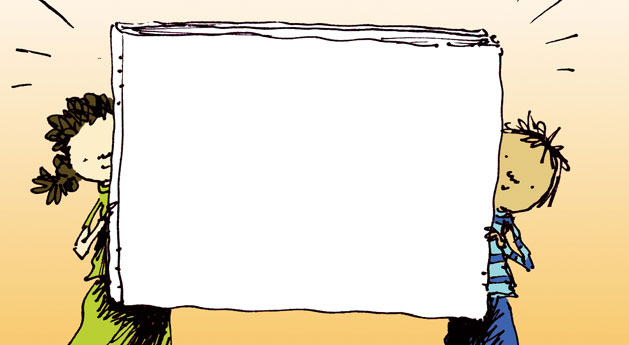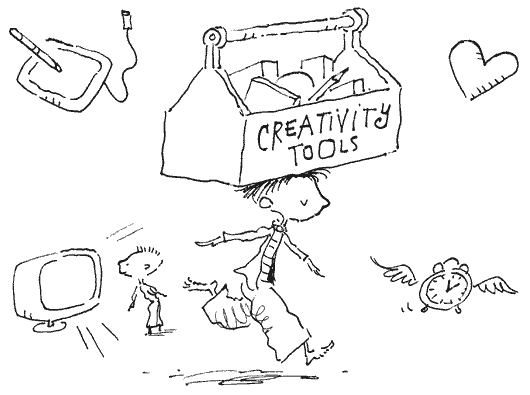
Blank books are symbols of what each of us is capable of creating.

Having been in the educational technology world for over two decades, people will ask me for suggestions for good software. While there are many captivating titles with sensational graphics, music and animation, I will suggest a guideline that is often quite surprising. Look for nothing. That’s right – nothing. Let me clarify. Look for “blank screen” software. Any title that has a blank screen as its “main attraction” is most likely a winner in my book.
The “content” is missing, the invitation to add your own is there, and the tools to allow you to do so.
Word processors, art programs, and music composing programs all beg for your creativity. Visual programming languages and animation programs demand your thinking, your problem-solving, and talent. These should be the programs we put at the fingertips of our students and our educators!
The following is an essay I wrote a few years ago which has served as inspiration for many creative people looking to “make their mark.”
I love nothing.
Sweet nothings.
I love the sweet, expectant nothingness of an empty page.
My nightly ritual is to make a mark, a line, a word, a drawing in my blank bedside journal. I flip through and search for that unclaimed page. The one begging for a late night scrawl and no matter how tired I am, I let the pen do its thing.
On some extra sleepy nights, it seems that the pen is more conscious than I. Days, weeks, months later, I can look back and marvel at the odd collection of dreamy words dabbled one after another. There is a special poetry in the subconscious that is allowed to spill out when our daytime guard is down. Isn’t it true that sometimes when we are trying our least, we sometimes are treated to our best—our most natural work?
I know for me my book, The North Star, cascaded from me during one of my late night page rituals. I wonder where that story may have ended up if it had only been lived out as a dream. Would there have been a repeat performance or would the story have been swept away into the deepest part of dream storage?
When I visit children in the classroom, I tell them about my journal and invite them to do the same. Children respond well to a simple invitation. Especially to play.
If we want kids to learn, to read, to write, then we should invite them to play. Play with words. Fill an empty page. With words. Drawings and even just doodles and marks. Let them discover first hand the joy of returning to the page a day later, a week later, and rediscover the page filled with their own thoughts and creations.
I often see people scurrying to buy gifts for family and friends and I think they should add one simple gift to the pile. A blank book. A simple one for less than a dollar will do. It doesn’t have to be deluxe. I have seen too many fancy journals sitting idle, blank and forlorn because its owner was too afraid to make a mark on its special pages. Simple will do nicely.
A blank book is tremendous for so many reasons. It binds together all the random art and writings into a portfolio. You can learn a lot from voyaging through a filled journal. You can appreciate the work. You can see improvements. You can be inspired by an idea and set off to build upon it in your next journal.
My dream library would have loads of books and equal amounts of blank books. A great big wall of “empties” waiting to be filled. I’d have buckets of pens, and glue, and paint ready for use.
Blank books are symbols of what each of us is capable of creating, contributing, and sharing. It symbolizes that each of us has an important story to tell. The blank book symbolizes that the best chapters are unwritten and just waiting to unfold.
The computer, you say? The blank pages of a creativity program? Are they as wonderful as a blank paper journal? While the experience is not as sensual, the effect is the same ultimately. I am a big advocate of any program that has a blank screen as its main screen. Blank screens, like blank journals, beg to be adorned, to be added to, to have life breathed into them. Set aside the super, whiz-bang, edutainment CD-ROMs and web sites and instead, pull up a good ol’ fashioned word processor or paint program and make it sing and sparkle.
Savor the blankness.
Marvel at nothing.
Be swept away by the glorious, wonderful, empty page.


Follow us on Instagram for daily inspiration

Create a thought web, cluster, flowchart, or other graphic organizer for a lesson
8 first projects to get students using technology
Creative, digital book reviews
Fun and powerful ideas with animated characters

Wixie
Share your ideas, imagination, and understanding through writing, art, voice, and video.

Rubric Maker
Create custom rubrics for your classroom.

Pics4Learning
A curated, copyright-friendly image library that is safe and free for education.

Wriddle
Write, record, and illustrate a sentence.

Get creative classroom ideas delivered straight to your inbox once a month.
Topics